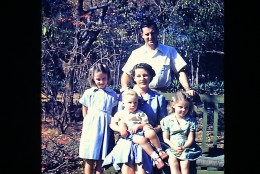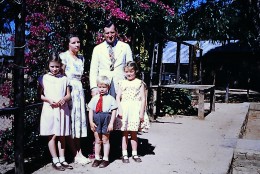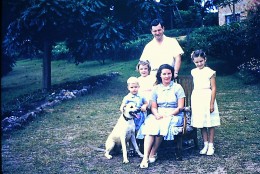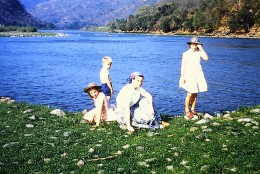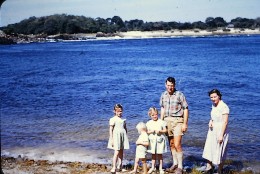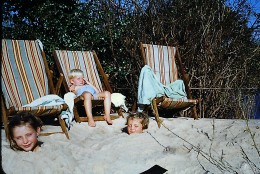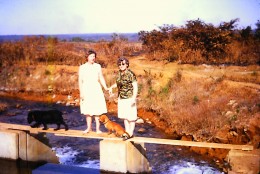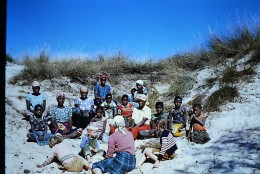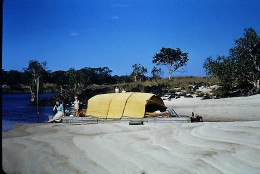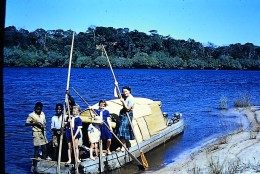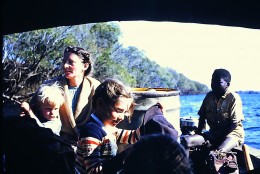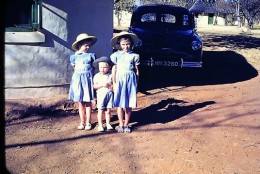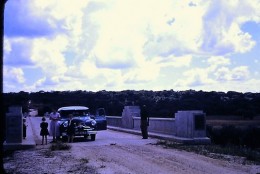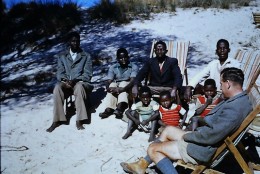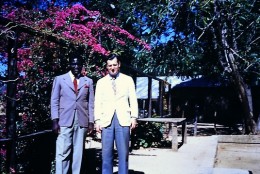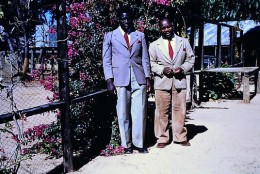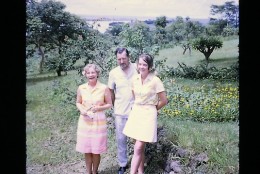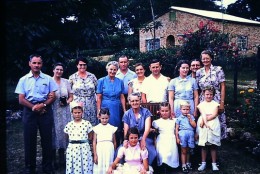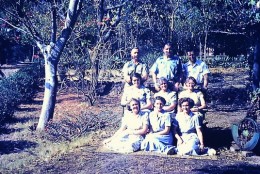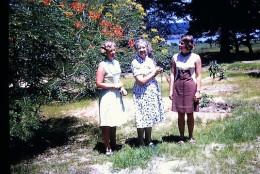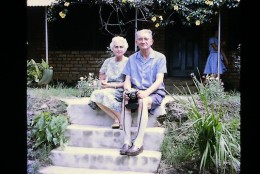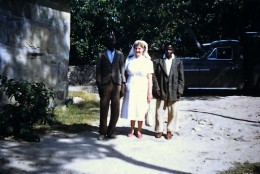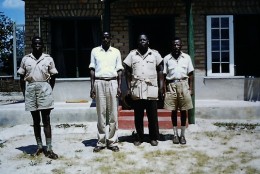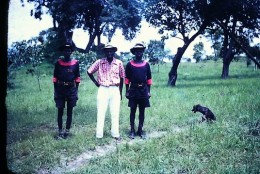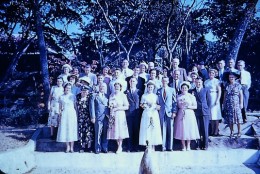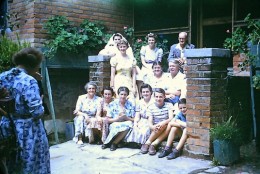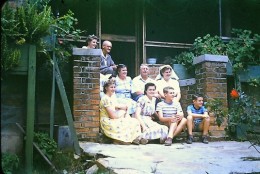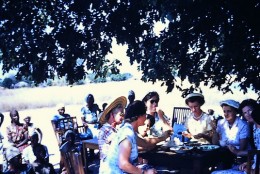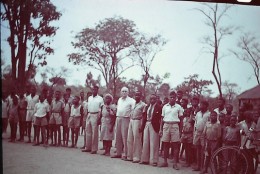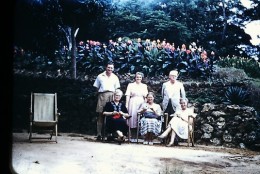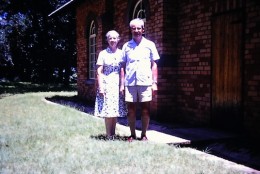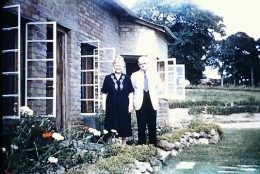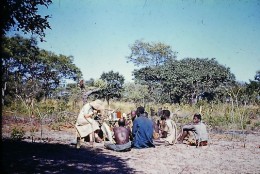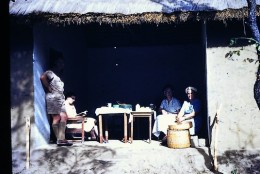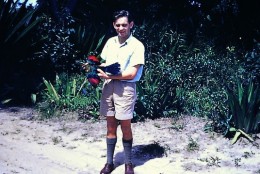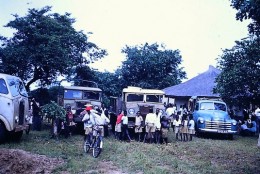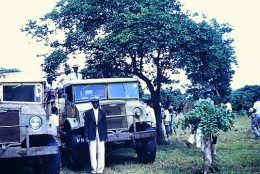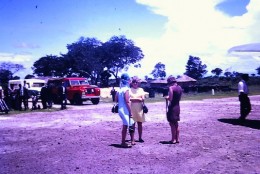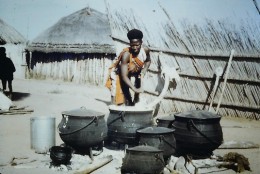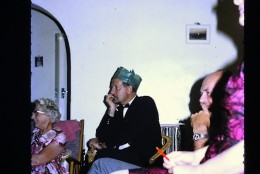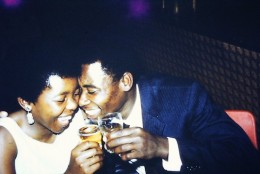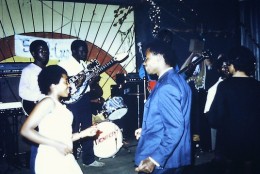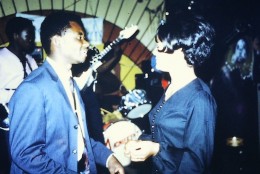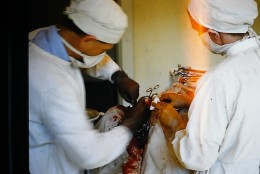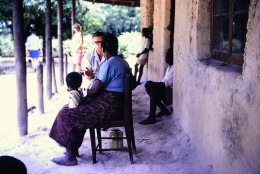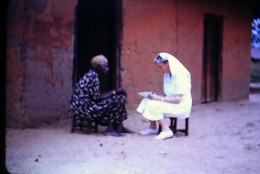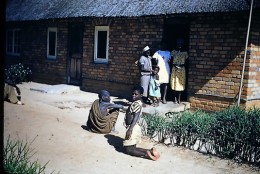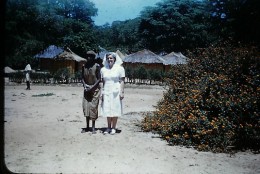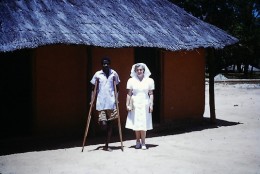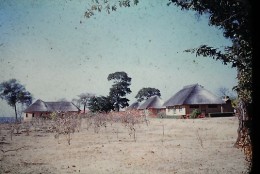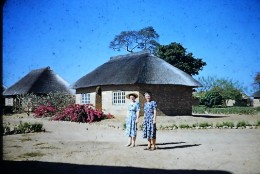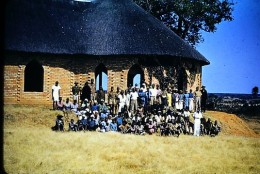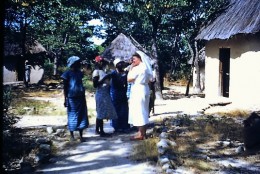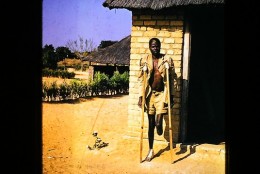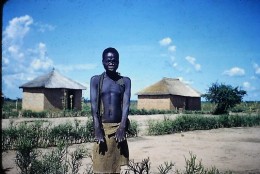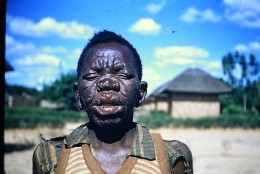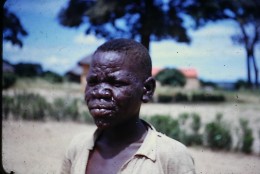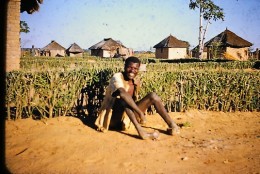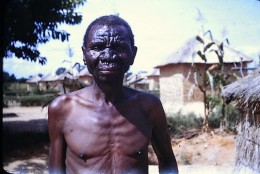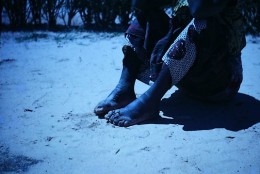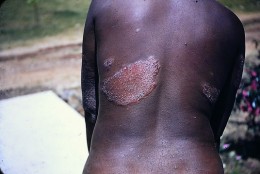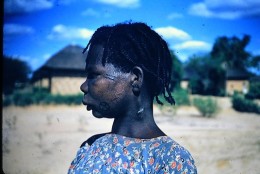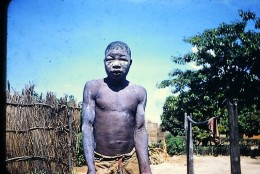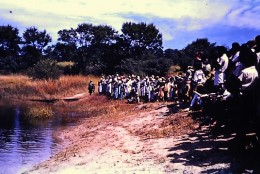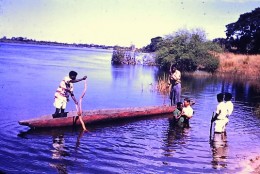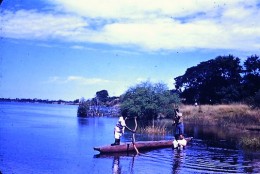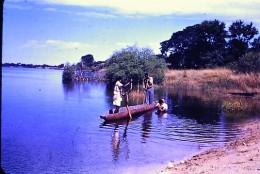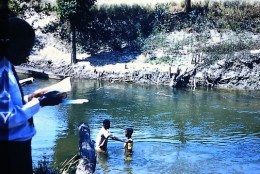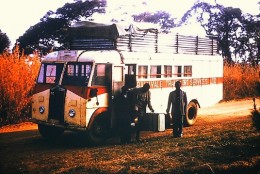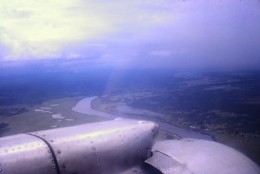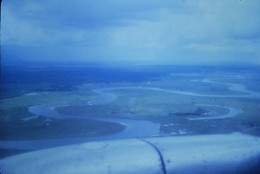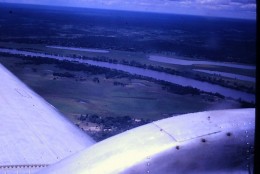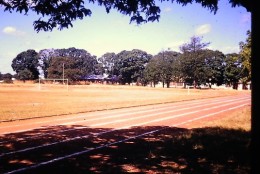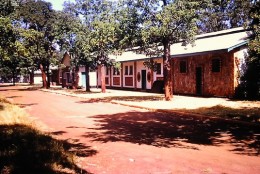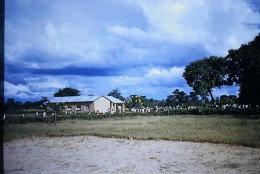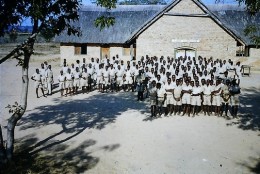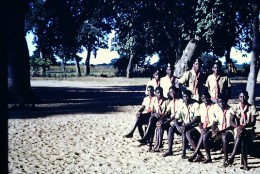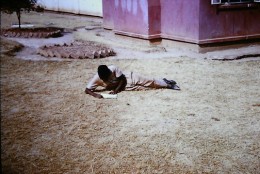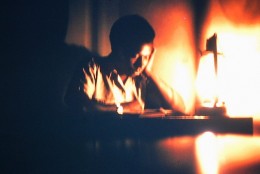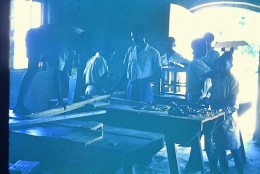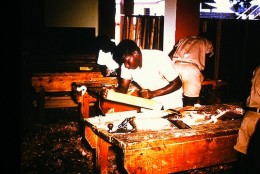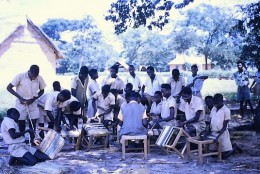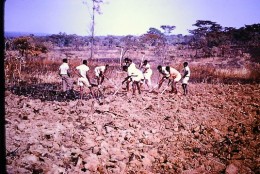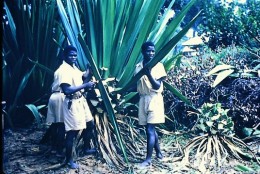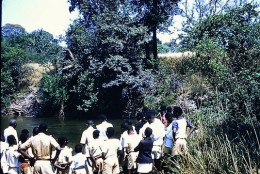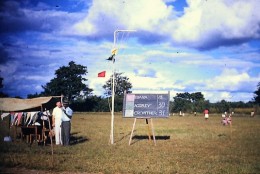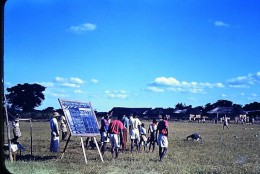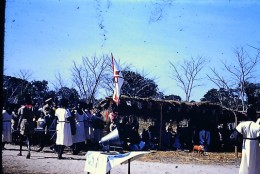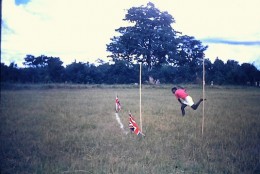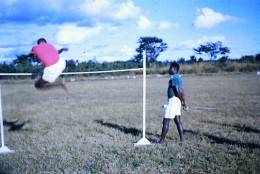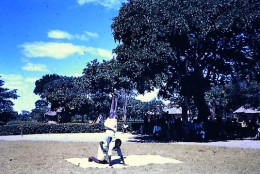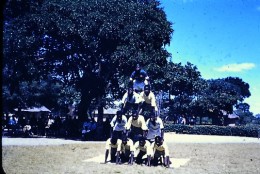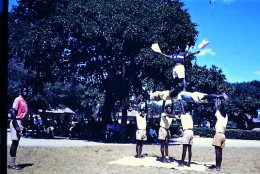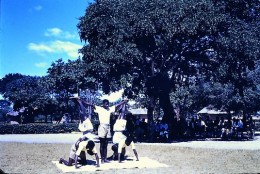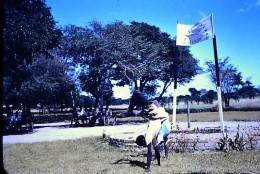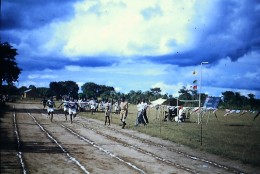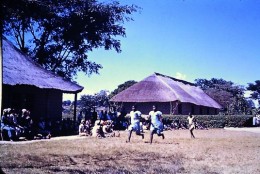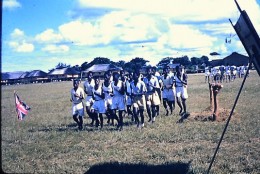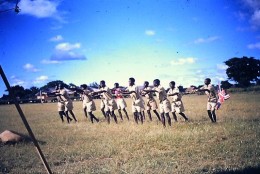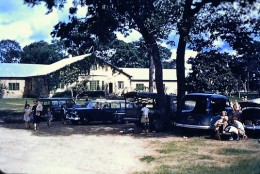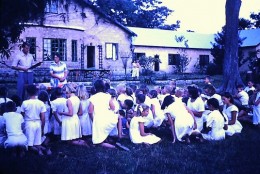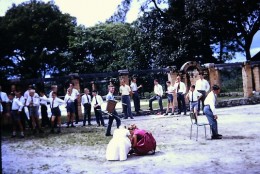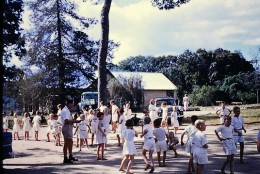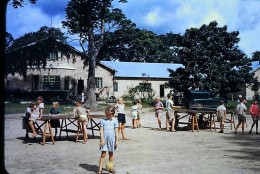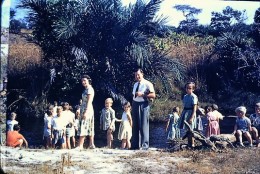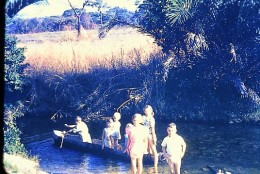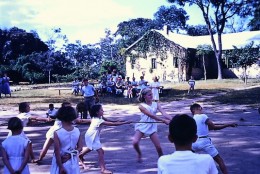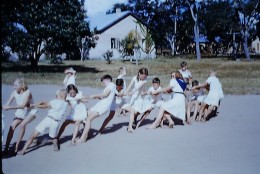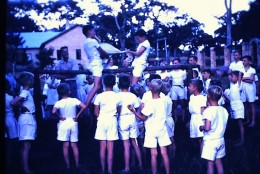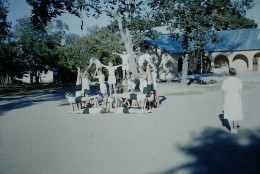Chitokoloki: 1950s, Part I (along with Part II) were Alex’s earliest of the NWP
Alex took these Chit’ pictures after arriving from the U.K. as a young missionary educator to run Chit’s Upper Primary School. They include not only the school, but also the surrounding Zambezi (then Balovale) District. Please note: I had to divide Chitokoloki (Chit’) pictures into two sub-pages because 212 pictures would not fit on a single page. Neither Alistair Nisbet (Alex’s son) nor I found any particular order for these photographs, nor discovered the year most were taken. Thus, I have placed them in an order pleasing to me. You can now judge!
While some individuals in these very old photos have been identified, most have not. If you can help, please use the form on the last webpage “You and Me: Should We Connect?” and contact me.
The row immediately below must have been among the first taken as Janette was born in 1945, Dileas in 1948 and Alastair in 1952. Since Alex and Marjorie arrived in Chit’ in 1950, probably these were all taken between 1954 and 1958. This first row was taken near their home with the far right photo taken in Dr. Worsfold’s garden with the family’s dog, Caesar. The next few rows were taken at or on the Zambezi River, which was within walking distance from their home.
- Janette left of Marjorie & Dileas to the right
- Left to right: Janette, Alastair & Dileas
- Alastair, Dileas & Janette (children left to right)
Chit’ was on a bend of the Zambezi River that was very sandy. The Nisbets relaxing at the river.
- Far left: Janette & far right: DIleas
- From left: Janette, Alastair & Dileas
- Left to right: Janette, Alastair, Dileas
Nisbet family with friends and associates in the 1950s.
- Marjorie (right) w/friend
- W/African friends
- W/fellow missionaries
The Nisbets and their family’s barge (flatboat) on the river. Dileas says that the family took a six week holiday up the Zambezi on the barge; in the middle picture from left to right are: Eddie Catali, Charlie, Dileas, Alastair, Janette and Marjorie (far right); and in the picture on the right is: Alastair, Marjorie, Janette and Charlie.
- At Zambezi River shore
- Pushing out into the Zambezi
- Out on the River
Off to Sakeji School. Traveling to Sakeji School (for missionary children) in Mwinilunga District near the Angolan and Congo borders involved a long journey on very difficult, dirt, roads: probably over 500 km. away. (See later photos of Sakeji School children at play.)
The picture on the left shows the Nisbet children (from left Dileas, Alastair, & Janette); in the middle they have stopped at a bridge over the Lunga River near Sakeji. Dileas says that on the right, Marjorie appears with the following children: back from left: Morag Campbell, Helen Mawhinney, and Janette; front from left: Dileas, Alastair, and Sheila Campbell. (Note: A later correction by Dileas: the left-most picture was not taken on the way to Sakeji but at a camp site at Livingstone in 1954 whilst they were on holiday.)
- 1954, Livingstone
- Crossing a main river
- Near Sakeji
Elders and friends. Below is Alex with village elders and friends. Left to right: on the Zambezi River beach; Alex with Willie Mwondela (middle); and is the rightmost picture is Willie again. (Other man not identified yet.) Willie, along with his brother John, played very important social and political roles both before independence and afterwards.
- Alex w/African friends
- Alex w/John
- Willie and ??
The next seven rows below, totaling 28 pictures, are a wide assortment of the Nisbet family, missionary colleagues, and African friends.
Chit’ Staff. Dileas has provided useful information about these pictures. The excellent left-most picture was taken many years after the others (Christmas 1969) on the Nisbet’s last visit to Chit’. In it, Marjorie, Alex and Dileas have the beautiful Zambezi River behind them. In the middle picture with Chit’ mission staff, the group included from back left: Mr. Caldwell, Nora Caldwell, Mrs Mawhinney, Mrs Deubler(?), Mrs. Worsfold, Dr. Worsfold, Mrs Nisbet, & Daisy Wareham; in the front row from left: Helen Mawhinney, Janette, Agnes Suckling, Morag Campbell, Alastair, & Dileas (in front of Sheila Campbell.) She later added that the Campbell girls came from northern Congo, and could only get home in the cold season because of the vast distance and poor roads. In the far right picture, the back row (from left) included David Mawhinney and Theo Deubler; the middle row: Sadie Mawhinney, Doris Deubler, & Daisy Wareham; the front row: Joyce Hull (later Mrs. Percy Smith), Marjorie and Hope Ruof (later Mrs. Bertram Rudge).
- Marjorie, Alex & Dileas: late 50s
- Chit’ mission staff
- Mission staff: Marjorie in front row middle
The top row (below), left: Marjorie, Norah Caldwell, & Dileas; in the middle: Dr. Theo (dentist) & Doris Deubler; on the right: Mrs. Worsfold and leprosy staff. In the second row are unidentified associates and workers at Chit’. (See known photo identifiers when you pass your cursor over the photo.)
- Note the monkey on the shoulder of the Norah (middle)
- Dr. Deubler (dentist) w/Doris, his wife
- Hilda Worsfold & leprosy staff
- Chit’ staff
- Messengers in uniform
- Probably a messenger w/river in background
The following row of photos are the Logan family at Chavuma mission. Note that Wallace Logan, the patriarch of that large family, appears in all photos. Dileas has identified individuals as follows:
- The wedding of Eunice (?) Logan and John Sims: front row from left: “Logan girl, Mrs. Logan SNR, Mr. Logan SNR, bridesmaid a Logan girl, best man? Eurice Logan (bride), groom John Sims, Logan girl (bridesmaid)”.
- Dileas reminded me that the photos on the right show all the five girls and two boys (Paul and Dr. David) in the Logan family.
- Wedding
- Logan family
- Logan family
Complex issues of the 1950s of Northern Rhodesia’s colonial society just before it started undergoing major changes are visible in the following row of pictures. The left photo shows African women and their babies in the background waiting to help the missionary ladies on their picnic by the river. In the middle are Chit’s students and staff with George Suckling in the middle. The large racially mixed group on the right show two groups of people awaiting officials, whether government or religious, we do not know.
- Picnic at the river
- George Suckling in the middle
- Waiting for someone
The following six pictures are possibly all Chit’ staff. Dileas adds some names: the top left picture (back row) includes: “Dr. Deubler(?) & George Suckling” and in front of them are: “Agnes Suckling(?) & Doris Deubler;” the top row middle are Norah & Jim Caldwell; and top right are George and Agnes Suckling (presumably in front of their home). We have no names for the people on the bottom row, but note the lady on the bottom left giving instruction.
- Dr. Deubler and George Suckling
- Norah & Jim Caldwell
- George & Mrs. Suckling
- Instructing
- Unknown
- Unknown bird and man
Annual mission/church conventions were (and still are) very important in the Brethren assemblies’ religious life. People came from far and wide as the vehicles show. Occasionally leaders flew in. The picture of Dr. Worsfold meeting a dignitary getting off the plane is, however, probably him meeting a leprosy official. The bottom middle picture shows the cook preparing food for the convention. (She seems to be cooking maize porridge (nshima). Dileas says that the party photo on the bottom right was taken at Christmas 1969. Mrs. Deubler is on Alex’s left and Mr. Maunsel on his right. (It has just been stuck in here to fill a space for pictures!)
- Gathering
- Gathering
- Gathering
- Dr. Worsfold meeting a plane
- Feeding the people
- Alex at a party
A wedding party: date of the wedding and names of the couple not known.
- Party 1
- Party 2
- Party 3
Medical work at Chit’ became important in the 1950s. George Sucking, Chit’s venerable leader, not only brought Alex Nisbet to expand education, but also James Worsfold (in 1947) to expand the medical work, both surgery and the leprosarium. (James married Hilda Seccombe, who had arrived in 1936, and was primarily involved with leprosy patients.) Both are shown in pictures below. Dr. Deubler had joined the mission in 1936 and was the only qualified dentist in the NWP and areas nearby.
The first row below shows Dr. Worsfold doing surgery, then talking to a leprosy patient. A note from Alex indicates that on the right Hilda is “dictating a letter with Nyakutemba.”
- Dr. Worsfold doing surgery
- Dr. Worsfold w/patient
- Hilda w/leprosy patient
Leprosy work was in transition in the 1950s and the early 1960s. New leprosy medications, now spread throughout the modern world were starting to be used. Leprosariums that isolated lepers were no longer necessary and were slowly being abandoned. Lepers were being re-integrated into society under close medical supervision. The horrible visible disfiguring of lepers as shown below is as unusual today in the NWP as in the rest of the world .
In the first row below is a small clinic and Hilda with patients (middle is Nyakutemba) and amputee on right. The second row shows Chit’s leprosarium village that still served much of the NWP in the 1950s and the lepers’ own church (far right). In the middle photo from left is Hope Ruoff and Joyce Hull, nurses who helped at the leper colony
- Clinic
- Hilda w/Nyakutemba
- Clinic
- Leper colony
- Joyce Hall (left) helped in leper colony
- Lepers’ church
The following four rows of pictures are meant to remind readers of how visually dis-figured and dis-formed in multiples ways lepers could be. Mr. Nisbet left several notes. One note identified Frances Logan on the top left. (I am not 100% sure if she was at Chit’s leper colony when the picture was taken.) The other note from Alex said “Hull” for three photos of different people. Presumably these individuals were being cared for by Joyce Hull. The top middle photo of an amputee may not be a leper.
- Francis Logas
- Amputee (may not be leper)
- “Hull”
- Leper
- “Hull” w/leper
- “Hull” w/leper
- Leper
- Leper
- Leper
- Leper
- Possibly a leper
- Leper
Baptism (full immersion) was important to the individual and community, as the Assemblies believed in each adult accepting salvation and making a spiritual break from his/her past life. The top left picture shows the assembly members gathered to witness the new believers being immersed, one by one. No one has been identified in these photos. The bottom right photo is not about baptism, but a note by Alex says it shows Chit’ mission from the air in the 1950s.
- Gathering of believers
- Baptismal scene
- Baptismal scene
- Baptismal scene
- Baptismal scene
- Chit’ from the air
Transport in the NWP to Chitokoloki. Trains stopped many hundreds of the kilometres to the east in the Copperbelt. The choices, besides walking, bicycles and cars were “bush” buses and planes. Upper left shows a typical 1950s bus, tough but hard on the spine! Drivers needed to be good mechanics caused by many breakdowns. See Chit’s mini airstrip for tiny airplanes next to the football grounds in the bottom right. Larger planes had to fly into Balovale’s (now Zambezi’s) government airport, about 50 km. to the north. In several pictures note the Zambezi River’s meandering path.
- Bus service to Chit’
- Flying into Chit’
- Zambezi’s meanders
- Zambezi from the air
- Zambezi from the air
- Airstrip at football pitch
Schools and school life. The next groups focus on schools and school life at Chit’, especially sports. Following these of Chit’ will be pictures of Sakeji School for missionaries’ children in Mwinilunga District. These also include many on sports. Except the Nisbet family at Sakeji, most individuals have not been identified.
Chitokoloki, primary schools nearby and student life.
- Probably Chit’ classroom
- Probably Chit’
- Probably Chit’ students
- Scouts
- Studying outside
- Studying w/paraffin lamp
Woodwork shop and duties around the school outdoors
- Woodwork shop
- Woodwork shop
- Crafts: making stools
- Manual work of clearing soil for planting
- Students w/sisal
- at the Zambezi
Sports at Chit’. Mr. Nisbet, as an organizer, appears in several photos. All others remain unidentified.
- Officials preparing event
- Getting ready
- Crowds gather
- Crowds gathered
- Sports
- Sports
- More sports
- More sports
- More sports
- More sports
- More sports
- More sports
- More sports
- More sports
- More sports
Sakeji School (for missionaries’ children) w/activities and sports. (See earlier pictures of the Nisbet family traveling to Sakeji from Chit.’) The first pictures have the main school buildings in the background.
- Main Sakeji buildings
- Main Sakeji buildings
- Sakeji students
- Sakeji students
- Sakeji: Sick bay in back
- Sakeji w/Dileas in foreground w/ dorm in background
As Dileas and others identify children, the names will be added. Pass your cursor over the pictures to see the names so far.
- Nisbet w/children at nearby stream
- Sakeji students
- Sakeji: Dileas left on rope
- Sakeji students
- Sakeji students: Janette 3rd from left on rope
- Sakeji students
- Sakeji students: Dileas faces camera
- Sakeji students
- Sakeji students: Includes Phyllis Lacey (later Mrs. Raymond)


